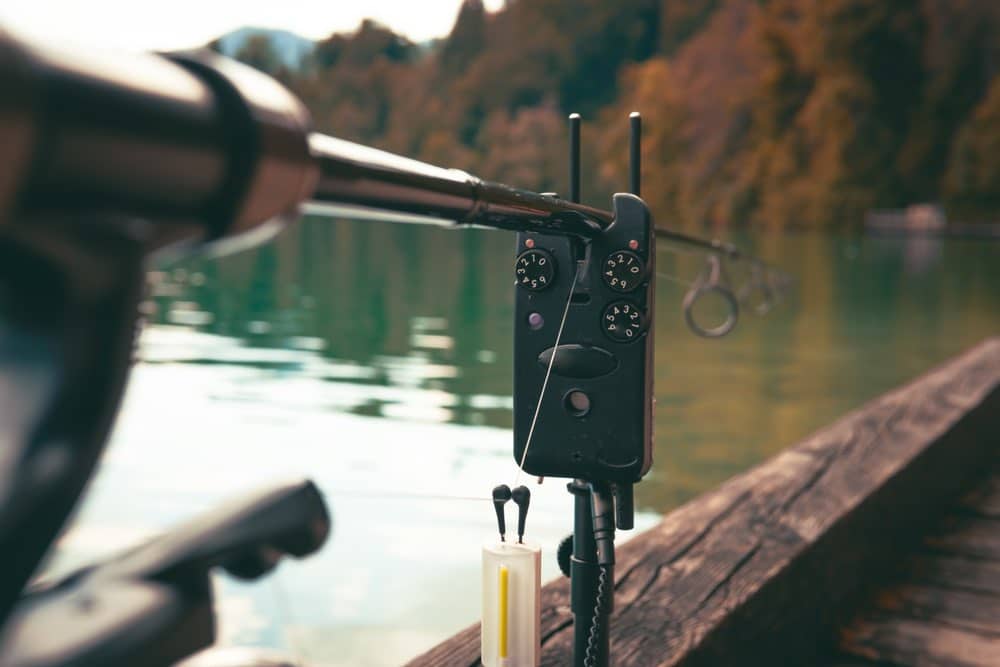Are you wondering if a fishing pole holder with a bite alarm is worth the cost?
Fishing rod alarms make it easier to catch more fish, and for many anglers, the more fish you catch, the better the fishing experience.
So is a fishing pole holder with a bite alarm worth it? Absolutely it is.
Related: What Color of Sunglasses Are Best for Fishing?
Contents
How to set up a bite alarm
Setting up a bite alarm is easy.
- Attach the bite alarm to its support. Most screw onto the butt rest. Make sure that the alarm is facing away from the water.
- Thread your indicator line from the bobbin or swinger into the bite alarm thread port. Most are a V-shaped notch. The line must sit in the notch, or it may not work well.
- Test the line by gently pulling it forward. The movement should activate the alarm.
Once the alarm is calibrated, you can cast out your line and place the rod in the holder. Then, again, position the line into the notch.
These are easy to use and set up. Some have adjustments to raise the alarm volume or dampen the alarm trigger, which is helpful if you are fishing in windy conditions.

How do you use a fish bite alarm?
The alarm detects movement from the line, a tug of the line when a fish bites or runs.
When line movement is detected, the alarm sounds.
Fish bite alarms are easy to use.
Once you have cast the line out, you set your rod into the rod holder and position the line into the grove.
You can use a bank stick and rest the pole on the sand or a bank stick with a butt rest, which holds the butt-end of your rod.
What a fish bite alarm does is it allows you to set multiple rods into play.
It also allows you more freedom while you are fishing. If you had to hold the rod the entire time, you would be more focused on the line and less focused on events around you.
Instead, sit back, have lunch, chat with your buddies, or spend some time teaching your kids to fish.
With a fish bite alarm, you have more freedom to enjoy the time fishing without being tied to the fishing rod.
When should you strike with a bite alarm?
If you are fishing for carp and have set up a bottom-weight, you would only engage the fish when it runs.
The bottom weight sets the hook for you, and as the fish swims off, the alarm sound.
If you have a two-drag reel, you will engage the fight drag by flicking the switch.
If not, you would give the spindle drag a quarter turn and slow the flow of the line.
If you have not set a bottom-weight, you will set the hook when the alarm continues to sound.
If you have only a few beeps and nothing, you can bet the fish are playing with the bait or lure.
Reel in and switch to another type of lure or bait.
Do not be discouraged if you are new to fishing and the alarm sounds just once, and nothing is on your hook.
That is a sign that fish are in the area, and they are investigating food options
If the trend continues, reel in your line and change baits.
How does a bite alarm work?
The bite alarm works by detecting either line movement or line vibration.
If you have a fish bite alarm with a spin wheel, it will detect the movement of the line.
If you have a fish bite alarm without a wheel, it will detect the line’s vibration.
Cast out the line and rest the pole on the support, Then place the line into the V-notch.
Anytime the line moves or vibrates (Depending on the bite alarm you have, ) the alarm will sound.
You can adjust the sensitivity of the mechanism, which is helpful in rainy or windy conditions.
Common Features
Most bite alarms have three settings; some have fewer. They include:
- Volume allows you to increase or decrease the volume of the alarm based on your activities or surroundings. If you are fishing with more than one rod, you could set each alarm to a different volume if you wanted.
- Sensitivity, which determines the amount of vibration or line movement before the alarm sounds. In windy or rainy conditions setting the sensitivity to a high setting (meaning it takes more to set off the alarm) would decrease false alarms caused by rain or wind moving the line.
- Tone, which allows for different alerts. If you are fishing with buddies and everyone has the same alarm pattern, you would have to rely on the lights or other mechanisms to find the alarming pole.
Ideal settings
How you adjust your fish-bite-alarm settings changes based on the weather, what you are doing, and where you are. The ideal settings include:
- Sensitivity — If you are fishing in harsh conditions, turn down the sensitivity so that it takes more action to set off the alarm. If you are fishing in calm environments, then turn up the alarm’s sensitivity so that it takes less to activate it.
- Volume — If you are busy enjoying your day and not paying attention to the line in the water, then turn up the volume. It will cut through your fun and alert when a fish starts to run your line. If it’s quiet out, and you are just relaxing, then turn the volume down.
- Tone — You can set the tone to be different from other anglers. Find one that you like and make that your go-to tone.
Types of batteries
Fish bite alarms come with many options. Batteries are a big deal. Bite alarms with rechargeable batteries can be a downer.
If the battery dies, you have to recharge the unit for it to work. Another option is the removable batteries; most take two AAA batteries.
A simple solution to a dead battery, in this case, is to carry extra batteries with you. Change the batteries, and you’re back to fishing.
Wireless or Wired
If you spend time away from your rod, then a wireless bite alarm is a good investment.
If you scout the local area for fishing spots or look around for bait, then it is a good chance you will be away from the rod.
Suppose you can hear the rod from where you are, great.
If not, you need a receiver, and the wireless system works with a receiver so that you can go in search of bait.
Sensors
There are two types of sensors available.
One is a magnetic wheel that spins when the line extrudes.
Each time the magnets click, they sound the alarm.
The other type of sensor is a vibrating sensor.
These are a Y-shaped gadget that the line sits in, and as the line moves, it tilts the Y causing a connection that sets off the alarm.
Is one better than the other? It is a personal choice.
In wind or rain, the vibration sensors can go off more often.
With the magnetic wheel, the line must move backward or forwards to trigger the magnets.
Bank Fishing vs. Boat Fishing
There are advantages to having a bite alarm in both situations.
If you fish from the bank, and you need to hunt for bait, or you are enjoying family time, then a bite alarm is ideal.
On a boat, if you want to study the electronic fish finder to locate schools of fish, then you can keep your line in the water and focus on other chores.
Bite alarms are ideal for both settings.
Cheap vs. Expensive
There are a lot of different brands, and they have different features.
Of course, you pay more for tools that last longer, but the cheaper bite alarms can be cost-effective if all you need is a simple alarm.
However, if you need to hunt for bait or scout for new fishing locations, a wireless bite alarm will cost more and serve you better.
Benefits of using a carp fishing bite alarm
There are many benefits to using a bite alarm, especially for carp.
The best time to fish for carp is at night when the weather warms and after the spring spawning.
As the weather warms, more insects emerge, and the night-flying insects attract carp.
The fish bite alarms allow you to sleep and fish at the same time.
In addition, if you have an alarm that allows you to change the volume or tone, you can tell whose rod is alarming and who has to get up to check for a fish.
Bite alarms work for many types of fish. Another target is pike, especially Northern Pike.
Final Thoughts
Many people use bite alarms for fishing, especially when fishing for carp.
Carp are nighttime feeders, so you can sleep or relax while fishing.
They are handy on a boat or for shore fishing, and especially for tournaments.
The range of bite alarms is such that you can enter the game for less than $50 and hit your local lake for carp season.







